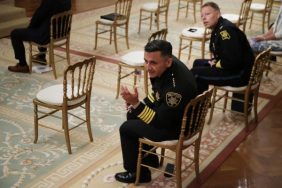Artwork: Installation View, Art Revolutionaries at Mayoral, 6 Duke Street, London. Image courtesy Mayoral.
The Spanish Civil War raged from 1936 to 1939, pitting the leftist Republicans against the right wing Nationalists led by General Francisco Franco. The Republicans launched a revolution trying to oust Franco from power, casting the struggle as a battle between tyranny and freedom. In response, the Nationalists conducted a counterrevolution using mercenaries along with support from Hitler and Mussolini, and ultimately won the war.
Also: “Mexique: 1910-1950 Renaissances” is a Mesmerizing Mosaic of a Country Coming into Its Own
Brutal and bitter, the Spanish Civil War prefigured the destruction that would descend upon the world stage just as it closed in 1939. But from this spectacle of horror and carnage came tremendous works of art—from Ernest Hemingway’s novel For Whom the Bell Tolls and Robert Capa’s photograph The Falling Soldier to Pablo Picasso’s masterpiece, Guernica, which he had completed in 1937. That same year, Picasso told The New York Times, “…I have always believed and still believe that artists who live and work with spiritual values cannot and should not remain indifferent to a conflict in which the highest values of humanity and civilization are at stake.”

Joan Miró, Personages, bird, stars, 1944, oil on canvas, 14x75cm (6x30in.), signed, dated and titled on the reverse. Inscribed on the back: Miró/1944/personnages, oiseau, étoiles
Picasso spoke for himself, and for an entire group of artists from his native land who were radicalized to create work that could speak to all peoples of the devastation they witnessed and the tragedy of war. An opportunity to share their work with the world arose in the form of the Spanish Pavilion at the 1937 Paris Exposition Internationale des Arts et Techniques dans la Vie Moderne. Artists seized the opportunity to reveal the cruelty of Franco’s regime, creating some of the most significant artworks of their careers including Picasso’s Guernica, Alexander Calder’s The Mercury Fountain, Julio González’s Montserrat, and Joan Miró’s El Segador (The Reaper).

View of exterior mural, Spanish Pavilion, 1937, Exposition Internationale des Arts et Techniques dans le Vie Moderne, Paris. Arxiu Históric del Col.legi Oficial d’Arquitectes de Catalunya, Barcelona, Photo by Roness-Ruan.
Now, on the 80th anniversary of this historic exhibition, Galeria Mayoral, London, presents Art Revolutionaries, now through February 10, 2017. Curated by Juan Manuel Bonet, Director of the Instituto Cervantes, Paris, and produced in collaboration with Joan Punyet Miró, historian, along with Fernando Martin and Josefina Alix, the exhibition features a selection of paintings and sculptures by Picasso, Miró, Calder, and González, alongside important archival material, such as rare propaganda posters from the original pavilion and a replica of Miró’s infamous work El Segador (The Reaper), which disappeared when the pavilion was dismantled in 1937.
Joan Punyet Miró, Miró’s grandson, explains, “El Segador reflected the pain, suffering and revolutionary angst of the Catalan people on seeing how their identity, their language and their culture risked being engulfed by a nationalist victory. It is important to note that this mural was produced specifically for the Republican Pavilion, as was Picasso’s Guernica.”

Alexander Calder, Crag with Yellow Boomerang and Red Eggplant, 1974, Láminas de metal pintado y alambre, 198.1 x 238.7 x 104.1cm, Pictures courtesy of Mayoral
The exhibition also pays tribute to the architecture of the Pavilion, designed by renowned Spanish architects Josep Lluís Sert and Luis Lacasa, which has since been dismantled. Art Revolutionaries features imitations of the façade, along with replica furniture to set the stage, along with archival materials like press coverage and footage of the Pavilion.
Art Revolutionaries reminds us of the importance of art to speak for those who have been silenced. Most of us can never fully perceive the horrors of war, and for that we should be grateful but not lose perspective or empathy of those whose lives have been destroyed as collateral damage to a political agenda that never cared about them in the first place. Just as the Pavilion portended a bleak future for the continent, we find ourselves looking at the possibility of history repeating itself, Art Revolutionaries reminds us that that we all must play our roles to stem the tides of destruction to protect ourselves from such a fate befalling us once more.
All Artwork: Courtesy of Galeria Mayoral.
Miss Rosen is a New York-based writer, curator, and brand strategist. There is nothing she adores so much as photography and books. A small part of her wishes she had a proper library, like in the game of Clue. Then she could blaze and write soliloquies to her in and out of print loves.








